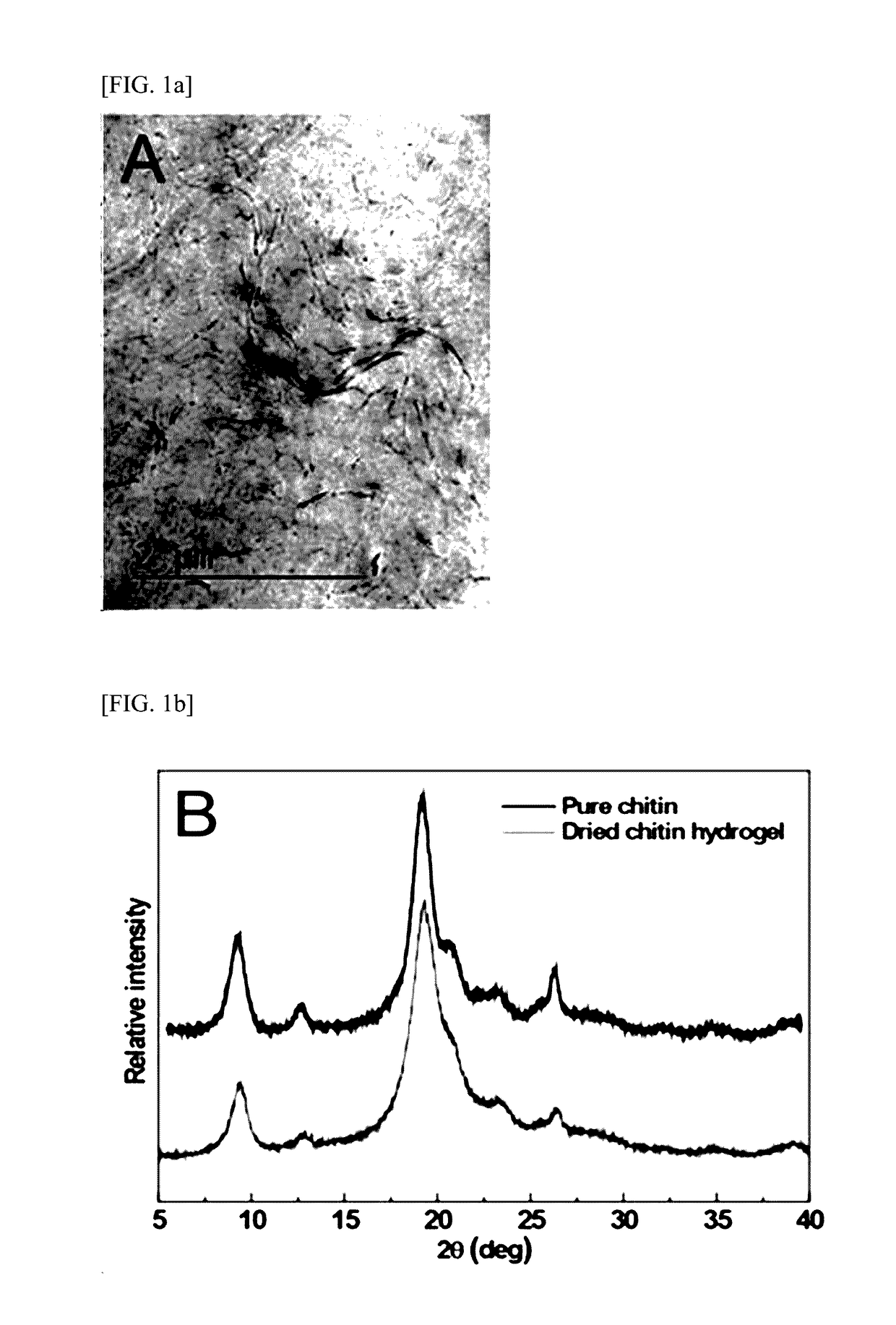Hydrogel including surface-treated nanofiber and preparation method thereof
- Summary
- Abstract
- Description
- Claims
- Application Information
AI Technical Summary
Benefits of technology
Problems solved by technology
Method used
Image
Examples
example 1
Preparation of Chitin Nanofiber Hydrogel
[0098]1-1: Preparation of Hydrogel including Chitin Nanofibers
[0099]In order to prepare a chitin nanofiber-based hydrogel, a method of H. Tamura et al. (Tamura, H., Nagahama, H. & Tokura, S. Preparation of chitin hydrogel under mild conditions. Cellulose 13, 357-364 (2006)) was employed.
[0100]First, 850 g of CaCl2 H2O was dissolved in 1 L of methanol, and 20 g of chitin was added thereto, followed by mixing at 150° C. for 6 hours. Thereafter, to precipitate the chitin nanofiber hydrogel, 20 L of distilled water was added to 1 L of the methanol solution containing chitin nanofibers. Then, calcium ions were removed by water-based dialysis (MWCO=1,000).
[0101]For deacetylation of the surface of the chitin nanofibers included in the hydrogel, mercerization was performed. Specifically, the chitin nanofiber hydrogel was refluxed in NaOH (20 wt %) for 6 hours to deacetylate the surface, and the surface-deacetylated chitin nanofibers were precipitated ...
example 2
Investigation of Gallic Acid Binding by Colorimetric Method
[0113]To quantify the content of gallic acid in the adhesive, a modified Arnow assay was performed together with a chitin hydrolysis method which is widely used in the analysis of amino acids and polyphenol extracts. 5 mg, 10 mg, and 15 mg of gallic acid and 25 mg of dried adhesive were sealed in a glass ampoule containing 500 μl of 6 M HCl and 20 μl of phenol (for minimal oxidation) under vacuum, respectively. The glass ampoules were heated to 110° C. 24 hours later, the solution in each glass ampoule was diluted 10-fold. 500 μl of 1.45 M sodium nitrite / 0.4 M sodium molybdate solution was added to 500 μl of each diluted solution, and color changes were observed. 1 ml of 1M NaOH was added to each diluted solution, and color changes were observed.
[0114]The color changes of each diluted solution are shown in FIG. 2C.
[0115]As shown in FIG. 2C, when 500 μl of 1.45 M sodium nitrite / 0.4 M sodium molybdate solution was added, the c...
example 3
Preparation of Adhesive Composition
[0116]In order to examine adhesive strength of chitin nanofibers surface-treated with gallic acid (pyrogallol acid) on the surface similar to a biological tissue, different adhesion tests were performed. A curing process is required in order to maintain adhesive strength in water of the hydrogel including gallic acid-conjugated chitin nanofibers prepared in Example 1. Different curing methods by pyrogallol, that is, a curing method by coordinate bonding with metal ions and a curing method by covalent bonding between moieties were performed to prepare two kinds of adhesive compositions.
[0117]As the first method by coordinate bonding, pyrogallol-conjugated chitin nanofibers prepared in Example 1 was mixed with FeCl3 at a molar ratio of pyrogallol:Fe3+ of 3:1, and cured by pyrogallol-Fe coordinate bonding to prepare an adhesive composition including the chitin nanofiber hydrogel surface-treated with Fe3+ and gallic acid.
[0118]As the second method by c...
PUM
| Property | Measurement | Unit |
|---|---|---|
| Fraction | aaaaa | aaaaa |
| Fraction | aaaaa | aaaaa |
| Pressure | aaaaa | aaaaa |
Abstract
Description
Claims
Application Information
 Login to View More
Login to View More - R&D
- Intellectual Property
- Life Sciences
- Materials
- Tech Scout
- Unparalleled Data Quality
- Higher Quality Content
- 60% Fewer Hallucinations
Browse by: Latest US Patents, China's latest patents, Technical Efficacy Thesaurus, Application Domain, Technology Topic, Popular Technical Reports.
© 2025 PatSnap. All rights reserved.Legal|Privacy policy|Modern Slavery Act Transparency Statement|Sitemap|About US| Contact US: help@patsnap.com



